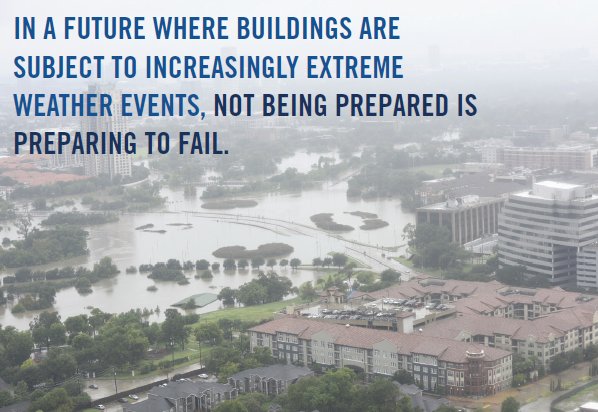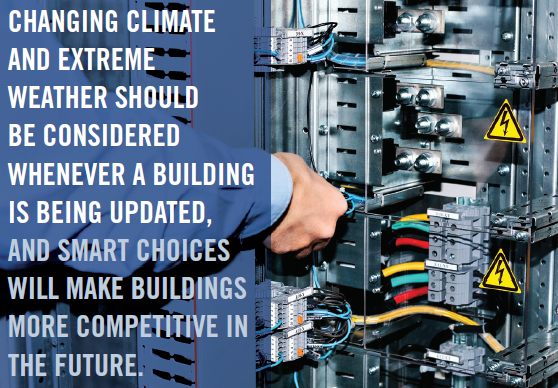For the commercial real estate industry, the effects of climate change are no longer the stuff of future fiction: Properties today are being heavily impacted by recordbreaking temperatures, more frequent flooding, unexpectedly strong winds and other weather extremes. According to the National Oceanic and Atmospheric Administration (NOAA), in 2017, the United States declared more billion-plus-dollar weather and climate disasters than in any previous year. The total damage for these disasters was $306 billion—almost $100 billion more than the next most expensive year.
The incidence of these expensive disasters is increasing, and NOAA is predicting that 25 states across the U.S. will suffer from damaging floods in 2019. Parts of the country are already facing everyday conditions that rival a 100-year flood; in fact, if you live in Houston, you’ve experienced what’s referred to as a "once in 500-year flood" every year for the last three years. According to the Risky Business Project, an organization devoted to quantifying the economic risks associated with climate change, $238 billion to $507 billion worth of property will be below mean sea level and will be chronically inundated by the year 2100. It can be tempting to think that these risks are isolated to only a handful of markets, but a full one-third of Climate Change of counties across the United States declared a disaster in 2017. Everyone should consider how they can help reduce the full impact of climate change as much as possible through their daily actions, but it’s becoming increasingly clear that our planet will look different in the coming decades.
IT PAYS TO PREPARE
Preparing for the impacts of climate change now is smart business. In fact, the National Institute of Building Sciences reports that for every $1 spent on hazard mitigation, the nation can save $6 in future disaster recovery costs. Savvy property owners and managers can significantly reduce the risks associated with extreme weather events by prioritizing resilience, human safety and financial security. Anticipating weather changes that affect building systems can help manage operating, maintenance, repair and recovery costs. Updating training and emergency procedures serves tenants, employees, investors and the community as a whole—and BOMA has resources to help.
Upgrading key building components and "hardening" building systems can decrease the cost of repair and recovery. These risk-reducing investments also may lower insurance costs. In a future where buildings are subject to increasingly extreme weather events, not being prepared is preparing to fail. The good news is that preparation represents a new opportunity for property professionals to reduce risk for tenants, increase their portfolios’ competitiveness and further strengthen their bottom line.
Not all regions will be impacted in the same way by climate change. While a familiar image of climate change is coastal real estate ravaged by wind and storm surges, elsewhere, climate change will bring different weather extremes: more hot days and nights; more frequent and persistent flooding; dramatic temperature swings; stronger and more frequent hurricanes and tornadoes; fresh water shortages; and more severe and frequent wildfires. It is critical to assess what the most likely weather risks for your location are and then identify the most impactful, cost-effective ways to adapt your property to be more resilient to those risks. New buildings can and should be designed and constructed to anticipate future conditions rather than today’s weather patterns and floodplain maps. Everything from building position to construction materials can be chosen for resilience to a predicted future climate. Existing buildings that were built for climate zones and weather patterns that now are changing will need to be adapted to survive.

ADAPTING FOR CHANGE
Changing climate and extreme weather should be considered whenever a building is being updated, and smart choices will make buildings more competitive in the future. Resilience strategies can be no- or low-cost or can be capital-intensive, but many of these adaptations can be done in the normal course of building updates. Following are several of the most common expected repercussions of climate change and some ways in which owners can plan resilient properties.
-
Flooding. Whether due to sea level rise and stronger storm surges or more abundant rain events, many areas of the country can expect more frequent flooding, with at- and below-grade building space facing the risk of more frequent inundation. Small things, such as installing and checking backflow valves in sewer lines to prevent sewage and storm water from backing up into drains, do not cost much, but can prevent costly clean-up. Buildings can be "wet flood proofed," meaning space is designed to tolerate short-term submersion. This includes raising critical infrastructure, such as electrical and mechanical systems above predicted future water levels, using materials that can withstand getting wet and ensuring that anything humans will need to interact with directly will remain above the future expected water level. Alternatively, buildings can be "dry flood proofed," by using physical barriers or other mechanisms like landscaping and water storage to divert water and keep flood-prone areas dry. While these solutions may be capital-intensive, they can prevent extremely expensive repair and replacement of equipment, as well as loss of life and property, and may lead to lower insurance premiums as a result.
-
Drought and Fire. For many regions, ironically, climate change will bring both heavier precipitation and periods of more intense drought, leading to higher risk of destructive fires. Building owners can ensure that exterior materials are as fire-resistant as possible: utilizing high-moisture plants, non-flammable materials for exterior furnishings and tempered glass windows near ground level. Properties should have a vigilant vegetation management plan that includes regularly removing dead leaves and plants and keeping vegetation away from structures.
-
Extreme Temperatures. Whether your region will experience hotter temperatures or more radical temperature swings, your heating, ventilating and air-conditioning (HVAC) systems will be working harder, and energy costs will be impacted. Smart building owners and managers can get ahead of these costs by performing energy and envelope performance audits and addressing air leakage issues; assuming a higher cooling load when designing HVAC systems; and investing in high-efficiency heating and cooling systems. Insulation, high-efficiency windows and window shading solutions can further increase the envelope performance and can be considered, particularly when looking at building renovation projects where some or all of these components are being updated anyway. Cool roofs and green roofs can lower building temperatures and reduce the heat island effect, and climate-tolerant landscaping can further mitigate temperature extremes. These interventions vary in cost, but they can add up to significantly lower operational expenses year after year, making properties more competitive and desirable over time.

-
Emergency Preparedness and Passive Survivability. With more extreme weather and stronger storms, there is an increasing chance that building owners and managers will have to manage an emergency, and that buildings might need to remain habitable through extended power outages, floods or other isolating situations. It is critical to assess and update your training and emergency procedures for building staff, tenants, service providers and visitors, including developing an emergency communications mechanism (such as a social media account). Building managers should assess the adequacy of backup systems, having IT and telecommunication systems connected to uninterruptible power systems (UPS) that can last for several days. Backup power and energy storage systems, located out of potential flood areas, may similarly need to be added or beefed up. Owners may want to consider on-site energy generation, such as solar photovoltaics, hot water, ice storage or other thermal cooling technologies, as an emergency backup strategy. Emergency systems can operate on direct current, so they can use on-site power in case of a grid outage. Buildings also can be designed with multiple modes of operation: a normal mode when utility power is available and a critical-systems-only emergency mode during power outages. Other potential adaptations might include operable windows for thermal comfort and fresh air in case of an extended power outage, or keeping on-site emergency food and potable water supplies.
Adapting a property for climate change can seem like a daunting task, but it should be viewed as an opportunity to further differentiate your properties. Buildings adapted for resilience—to minimize the risk to lives, businesses and facilities from future weather disasters—will continue to be more competitive and more financially sound over time.
ABOUT THE AUTHOR: Brenna Walraven is the president & CEO of Corporate Sustainability Strategies, Inc., an independent commercial real estate operations and sustainability consulting firm. She also is a past chair of BOMA International.
This article was originally published in the May/June 2019 issue of BOMA Magazine.